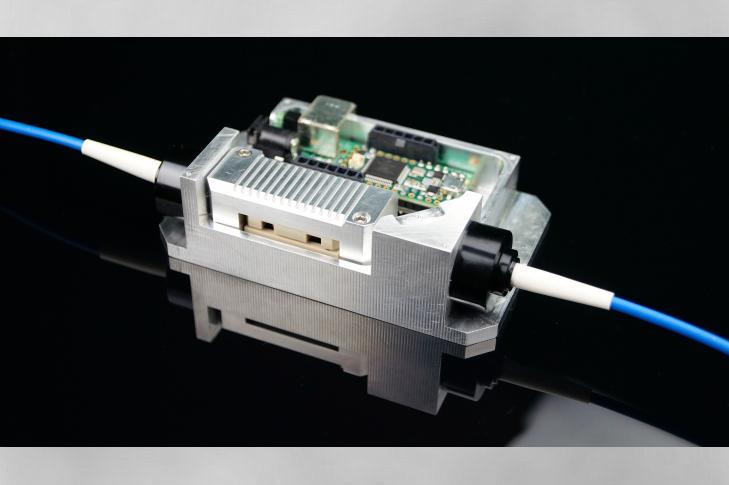Jul 26 2017
A technique developed at Oak Ridge National Laboratory for synthesizing photons, or quantum light particles, in an as-needed and controlled way—that ensures enhanced speed and security while sharing encrypted data—has been non-exclusively licensed by Qubitekk.
 An existing Qubitekk prototype will leverage ORNL’s single-photon source approach, bringing the device closer to generating pairs of quantum light particles in a controlled, deterministic manner that is useful for quantum encryption. CREDIT: Qubitekk.
An existing Qubitekk prototype will leverage ORNL’s single-photon source approach, bringing the device closer to generating pairs of quantum light particles in a controlled, deterministic manner that is useful for quantum encryption. CREDIT: Qubitekk.
Prevalent encryption methods are based on complicated mathematical algorithms for coding information that can be interpreted only by the recipient who has the encryption key. The scale, frequency and sophistication of cyber threats in the energy industry are ever increasing. A research team, inclusive of Researchers from the Department of Energy’s ORNL, has been working to tap the quantum characteristics of photons to empower innovative cryptographic technologies with the ability to protect crucial network infrastructures in a better manner.
Quantum Information Scientists have long ago identified that photons are advantageous for quantum computing or safeguarding sensitive information. Yet, systems with the ability to liberate single photons specifically achieve this at random times, and it is challenging to produce such photons in a deterministic way.
In order to achieve this, the ORNL Researchers employed a technique called down-conversion, which yields not one but two photons.
The occurrence of paired photons is random and unpredictable. But, it’s that randomness that we wanted to harness and use to our advantage. The trick then is to direct the heralded photon using a combination of high speed and low-loss operations, so that it appears when needed.
Warren Grice, ORNL Co-Inventor
In order to prevent the loss of the photon pairs, the Researchers developed the prevalent concepts of multiplexing, a process that involves using a sequence of light source systems including components commonly used in fiber-optics. The ORNL system adjusts the frequency and speed of the detected photon in the frequency domain that prospectively minimizes the loss of single photons.
The goal is to specify and control every aspect of the photon’s quantum state, constraining everything to a single mode so that the photons emitted from the single-photon source are identical—each one indistinguishable from the next.
Nicholas Peters, an ORNL Co-Inventor
By using the identical photon pairs, quantum key encryption technologies for safeguarding information from cyber attacks upon being shared over prevalent machine-to-machine networks can be developed.
A San Diego-based quantum technology company, Qubitekk has worked to design a quantum encryption device that can be developed by using the single-photon source concept, and also aspires to reinforce the technology by further advancing ORNL’s innovative approach.
The idea of a nearly on-demand, single-photon source can be used to increase the speed, or data rates, and the distance you can send the quantum keys when transmitting encrypted information. The ORNL technology could address both of those issues, which could move our product closer to commercialization.
Duncan Earl, President and Chief Technology Officer of Qubitekk
Earl intends to improve the prevalent quantum information prototype used by the company by combining the fundamental design with ORNL’s idea. This can lead to either 10-fold increase in quantum encryption data rates or sustenance of prevalent data rates over considerably longer transmission distances.
The ORNL-developed technology adopts the basic principles of quantum physics to uncover, in real-time, the existence of an adversary trying to obstruct the exchange of secret keys used in cryptographic algorithms for protecting energy sector information communicated among legitimate parties. Hence the technology has the ability to strengthen operational networks employed to control power grid functions, thus advancing the aim of the energy sector, which is to develop strong and fool-proof energy delivery systems that can withstand a cyber attack.
Joseph Lukens, Nicholas Peters and Warren Grice from ORNL’s Computational Sciences and Engineering Division invented the deterministic single-photon source idea. In the past 10 years, they have investigated techniques for emitting and calibrating the synthesis of single photons, with the aim of improving quantum information applications such as sensing, communication and computing.
Earl—who is a former ORNL Researcher associated with the Cyber Warfare group and the Quantum Information Sciences team of the lab—anticipates that Qubitekk will further create the single-photon source design at the company’s own facility and aims to develop field tests with their prevalent customers, inclusive of utility companies based in California. ORNL will extend additional assistance as and when it is necessary.
The DOE’s Office of Electricity Delivery and Energy Reliability’s Cybersecurity for Energy Delivery Systems (CEDS) program and ORNL’s Laboratory Directed Research and Development program funded the study.